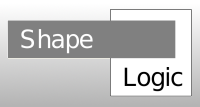
ShapeLogic comes with a test application for letter matching, the purpose of which is to show how to use the ShapeLogic framework on a simple well defined problem.
Currently 3 sets of rules have been defined:
The matching example is not very robust yet, and is made to match letter in sans serif typefaces, e.g. Ariel or Helvetica.
Unit test exist for all capital letters.
Matched images can be found in this directory:
shapelogic/src/test/resources/images/smallThinLetters
See the Getting Started page.
Lines and points are annotated in order to match curves, circle arches or Bezier curves are not used. Lines and points can be filtered according to both position in the bounding box for a polygon, and point and line annotations.
For a better description of logic language syntax.
new NumericRule("A", POINT_COUNT, polygon, VAR_SIZE_START + POINT_COUNT_EX + VAR_SIZE_END,"==", 5.),
new NumericRule("A", HOLE_COUNT, polygon, VAR + HOLE_COUNT_EX, "==", 1.),
new NumericRule("A", T_JUNCTION_LEFT_POINT_COUNT, polygon, FILTER_START + T_JUNCTION_LEFT_POINT_COUNT_EX + FILTER_END,"==", 1.),
new NumericRule("A", T_JUNCTION_RIGHT_POINT_COUNT, polygon, filter(T_JUNCTION_RIGHT_POINT_COUNT_EX),"==", 1.),
new NumericRule("A", END_POINT_BOTTOM_POINT_COUNT, polygon, filter(END_POINT_BOTTOM_POINT_COUNT_EX), "==", 2.),
new NumericRule("A", HORIZONTAL_LINE_COUNT, polygon, size(HORIZONTAL_LINE_COUNT_EX), "==", 1.),
new NumericRule("A", VERTICAL_LINE_COUNT, polygon, size(VERTICAL_LINE_COUNT_EX), "==", 0.),
new NumericRule("A", END_POINT_COUNT, polygon, VAR + END_POINT_COUNT_EX, "==", 2.),
new NumericRule("A", SOFT_POINT_COUNT, polygon, size(SOFT_POINT_COUNT_ANN_EX), "==", 0.),The meaning of the rules for A is:
new NumericRule("C", HOLE_COUNT, polygon, VAR + HOLE_COUNT_EX, "==", 0.),
new NumericRule("C", T_JUNCTION_POINT_COUNT, polygon, filter(T_JUNCTION_POINT_COUNT_EX), "==",0.),
new NumericRule("C", END_POINT_BOTTOM_POINT_COUNT, polygon, filter(END_POINT_BOTTOM_POINT_COUNT_EX), "==", 1.),
new NumericRule("C", MULTI_LINE_COUNT, polygon, size(MULTI_LINE_COUNT_EX), "==", 1.),
new NumericRule("C", VERTICAL_LINE_COUNT, polygon, size(VERTICAL_LINE_COUNT_EX), "==", 0.),
new NumericRule("C", END_POINT_COUNT, polygon, VAR + END_POINT_COUNT_EX, "==", 2.),
new NumericRule("C", INFLECTION_POINT_COUNT, polygon, size(INFLECTION_POINT_COUNT_EX), "==", 0.),
new NumericRule("C", CURVE_ARCH_COUNT, polygon, size(CURVE_ARCH_COUNT_ANN_EX), ">",1.),
new NumericRule("C", HARD_POINT_COUNT, polygon, filter(HARD_POINT_COUNT_EX), "==", 0.),
new NumericRule("C", SOFT_POINT_COUNT, polygon, size(SOFT_POINT_COUNT_ANN_EX), ">", 0.),The meaning of the rules for C is:
/** Before a type is determined */
UNKNOWN,
/** Not completely straight */
STRAIGHT, //only a start and an end point
/** only on one side of a line between the start and end point */
CURVE_ARCH,
/** On both sides of a line between the start and end point
* this is the rest category for lines */
WAVE,
/** Means that this is an arch and that it is concave compared to 1 or both
* neighbor points, meaning they are on the same side of the line as the
* arch */
CONCAVE_ARCH,
/** This line contains an inflection point, meaning the end points have
* different signed direction changes */
INFLECTION_POINT,
/** For multi lines, if 2 lines are added together */
STRAIGHT_MULTI_LINE, /** Before a type is determined */
UNKNOWN,
/** If the point has a sharp angle for now 30 degrees is set as the limit */
HARD_CORNER,
/** If it is not a hard point */
SOFT_POINT,
/** 3 or more lines meets, U is for unknown */
U_JUNCTION,
/** 3 lines meet 2 are collinear and the last is somewhat orthogonal */
T_JUNCTION,
/** 3 lines meet less than 180 degrees between all of them */
ARROW_JUNCTION,
/** 3 lines meet, not a T junction */
Y_JUNCTION,
/** point is an end point,
* maybe later there should be a distinction between end points and have
* nothing else close by and end points that have close neighbors */
END_POINT,